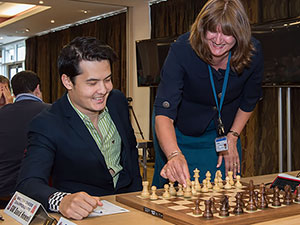


Until 2003, the tournament was open to players of all the Commonwealth countries, however, after victories by GM R. B. Ramesh in 2002 followed by GM Abhijit Kunte in 2003, it was argued that the tournament was not serving the interests of the British players. Hence, from 2004 it was announced that only British and Irish players would be allowed to participate in the British Championships.

The campus of Warwick University where the British Championships are currently being held
The tournament is an eleven-round Swiss event with 75 participants including eleven grandmasters and three International Masters. The schedule of the tournament is excellent with one round every day and a rest day after six rounds on the 2nd of August.

The playing hall that hosts various events from the British Chess Festival
This edition has sparked interest because of the participation of David Howell who recently broke the 2700 rating barrier and is currently world number 33. He looks forward to defending his title for the third time in a row. After six rounds, two players are in joint lead with 5.5/6 – David Howell and Daniel Gormally.

With wins over strong players like Simon Williams, Richard Pert and John Emms, David Howell
is in the joint lead with 5.5/6

Daniel Gormally has been the only one to stop David Howell and
has demolished all his other opponents. By beating Chris Ward
and Jonathan Hawkins, he is having a great tournament with 5.5/6,
gaining 15 Elo points so far and a 2721 performance.
The fight between the two leaders was a topsy-turvy battle, and Howell was pushing throughout the game with his superior knight against Gormally’s bad bishop. The 2700+ player had several winning opportunities but could not convert them. Finally the game ended in a draw after a 120-move marathon in which Daniel defended with great tenacity. The funny thing here is that after 117 moves, Gormally finally gets his winning chance, albeit far from easy to see, but even with a second chance on move 119 he misses his opportunity. Theoretically, the final position still offers the winning shot, but since it also represented a three-fold repetition, the game was a draw.

Gormally’s tweet after the game

David has already played 1.Nf3, 1.d4 and 1.c4 at the event. Only 1.e4 remains to be tried!
Here’s an example that showcases what a cool and calm calculator David is:
Charles Storey – David Howell, (round two)
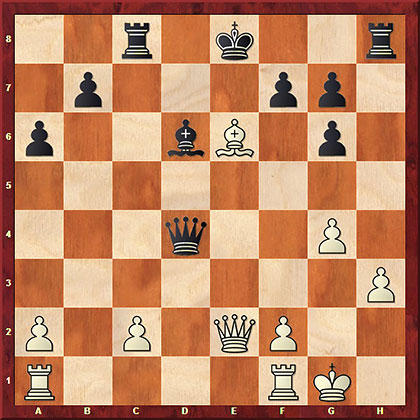
White's move last was Bd5xe6. The rook on c8 is hanging. What would you play as Black?

Charles Storey at the start of the game waiting for Howell to turn up
IM Andrew Martin analyses the game Charles Storey – David Howell in his Game of the Day Video
If David Howell is calculating sharply and accurately, his co-leader Daniel Gormally is not far behind. Here is one position which shows his brilliant creativity and control over the geometrical motifs on the chess board.
Chris Ward – Daniel Gormally, (round five)
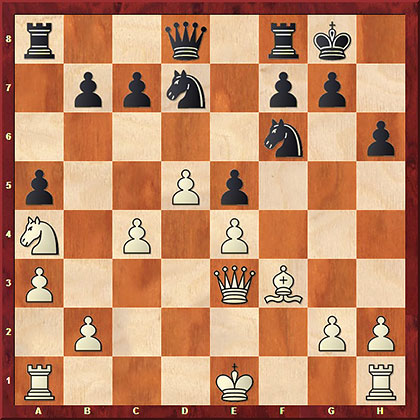
The position is about equal but Gormally stirs up complications in
fantastic fashion. Can you find the move Black played?
IM Andrew Martin’s analysis of the game Chris Ward - Daniel Gormally in his Game of the Day video

Nick Pert is in third place and is the only player on 5.0/6
Nicholas Pert – Mark Hebden, (round six)
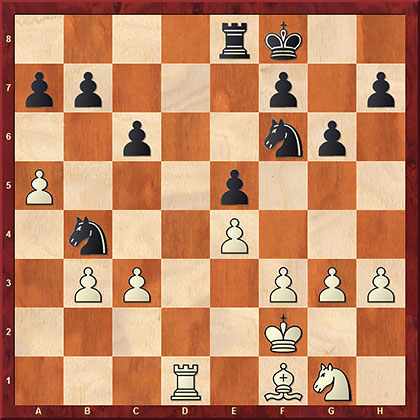
The position is roughly equal. The black knight is under attack on b4 and
has three squares at his disposal – a6, c2 and a2. a6 looks incorrect as
after Bxa6, black’s pawn structure is ruined. What should Black play?
Nc2 was definitely the best choice. But Hebden moved his knight to a2 attacking the c3 pawn and after Pert’s simple Ne2, the black knight was trapped on the edge of the board! With Ra1 coming up, Hebden found nothing better to do than to throw in the towel.
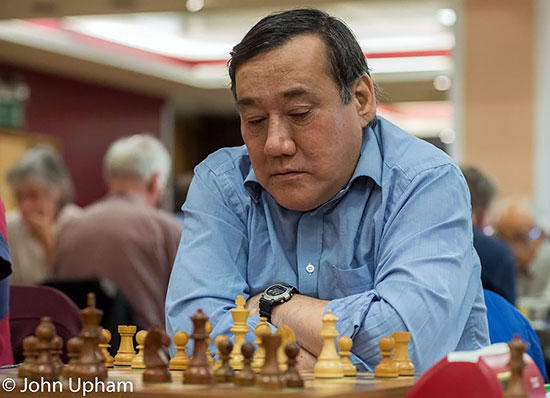
The six-time British Rapid play Champion Mark Hebden had a bad day at the office in the sixth
round. He is currently on 4.0/6.

Jonthan Hawkins, also known as the Hawk, is considered as one of the most solid British players
He was joint winner at the British Championships in 2014 along with David Howell. This year he has suffered a defeat at the hands of Daniel Gormally in the sixth round but with a score of 4.5/6 he has every chance to make a successful comeback. Hawkins is also the author of a very nice book named Amateur to IM where he discusses the methods that had helped him to become an International Master.

The endgame virtuoso Keith Arkell is currently on 4.5/6

All those who know Simon Williams know what a complete
hacker he is at the chess board. Simon is also the author of
numerous Fritztrainer DVDs for ChessBase. His most beloved
DVD is the one entitled “Most Amazing Moves”.
|
“Players die, tournaments are forgotten, but the works of great artists are left behind them to live on forever.“ - Mikhail Tal's amazing moves have the power to enlighten both the heart and soul of any chess player. Like the paintings of a master or the timbre of a symphony, amazing chess moves can appeal to players in a wholly aesthetic way. This interactive DVD guides the viewer through some of the most beautiful and amazing chess moves in early to modern chess. • Video running time: 5 hours 30 minutes |
|
|
Click here to order Most Amazing moves in the ChessBase Shop |
|
Williams likes to practice what he preaches. In this tournament when he was up against the top seed David Howell in the fourth round, instead of playing solidly, he stayed true to his style and tried to create an “amazing attack” out of nothing. He sacrificed so many pieces that in the end was left with absolutely nothing!
Five rounds remain at the British Championships 2015. Will Howell successfully defend his title for the third time in a row or will Gormally maintain his excellent form and win the British Championship for the first time in his career?

IM Andrew Martin (right) with IM Ravikumar Vaidyanathan doing the live commentary for the
event. You can follow the live commentary on the Youtube channel of English Chess Federation.
A demolition job: Hawkins – Wager
A classic match between youth and experience: Golding - Arkell
Two old friends and rivals from Leicester slug it out: Flear - Hebden
Pictures from the official website
|
Rk
|
SNo
|
Ti.
|
Name
|
Rtg
|
Pts
|
| 1 | 1 | GM | Howell David W L | 2698 | 5.5 |
| 6 | GM | Gormally Daniel W | 2484 | 5.5 | |
| 3 | 2 | GM | Pert Nicholas | 2562 | 5.0 |
| 4 | 3 | GM | Hawkins Jonathan | 2554 | 4.5 |
| 4 | GM | Arkell Keith C | 2502 | 4.5 | |
| 7 | GM | Emms John M | 2460 | 4.5 | |
| 8 | GM | Flear Glenn C | 2450 | 4.5 | |
| 9 | IM | Pert Richard G | 2440 | 4.5 | |
| 12 | GM | Summerscale Aaron P | 2416 | 4.5 | |
| 30 | Hill Alistair | 2159 | 4.5 | ||
| 11 | 5 | GM | Hebden Mark L | 2500 | 4.0 |
| 10 | GM | Williams Simon K | 2426 | 4.0 | |
| 11 | GM | Ward Chris G | 2423 | 4.0 | |
| 14 | IM | Cooper John G | 2313 | 4.0 | |
| 15 | FM | Batchelor Peter J | 2304 | 4.0 |
LinksThe games are being broadcast live on the official web site and on the chess server Playchess.com. If you are not a member you can download a free Playchess client there and get immediate access. You can also use ChessBase 13 or any of our Fritz compatible chess programs. |